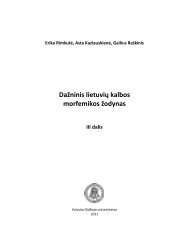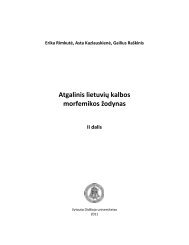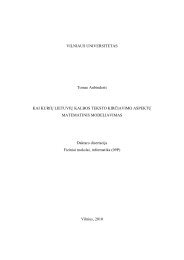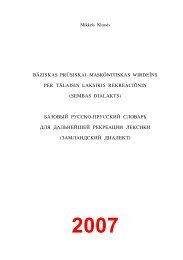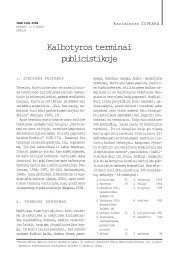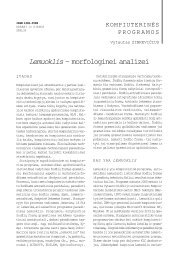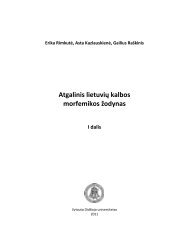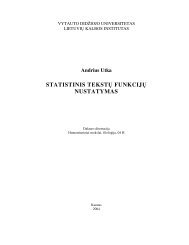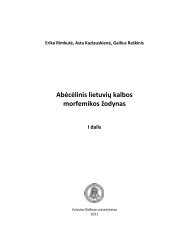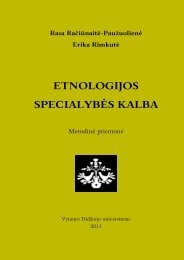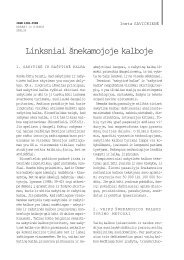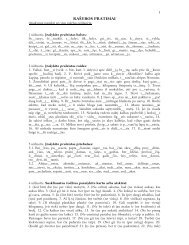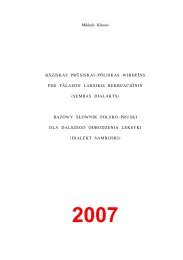HISTORICAL GRAMMAR OF OLD PRUSSIAN
HISTORICAL GRAMMAR OF OLD PRUSSIAN
HISTORICAL GRAMMAR OF OLD PRUSSIAN
Create successful ePaper yourself
Turn your PDF publications into a flip-book with our unique Google optimized e-Paper software.
<strong>HISTORICAL</strong> <strong>GRAMMAR</strong> <strong>OF</strong> <strong>OLD</strong> <strong>PRUSSIAN</strong><br />
* 18. In several instances Balt. *ô is reflected in Pr. Cat. ` (not after<br />
LG), cf. (III) d`t ‘to give’, d`twei ‘idem’ (cf. Lith. dƒuoti, Latv. du°ot < Balt.<br />
*dô-), d`ts (III) ‘given’, dats (I) ‘idem’, daeczt (II) ‘idem’ = d`ts. This `<br />
came to being in the following way. The root vowel Balt. *ô was unstressed<br />
in oxytone forms of this verb [the verb belonged to mobile type<br />
of accentuation, of what the “broken” tone in Latvian is the best evidence<br />
– L.P.]. As unstressed, this *ô was broad *¯É and thus coincided with Balt.<br />
*¯É < (=) Balt. *`, i.e. so-called neutralization of */ô/ and */¯É = *`/ took<br />
place. Since 2 different root-vowels are not desirable in paradigm of the<br />
same word, one of the both had to be generalized onto the whole paradigm.<br />
In Prussian this was the unstressed *¯É. Thus Balt. *dô- ‘to give’<br />
turned into WBalt. *d¯É ‘idem’ > Pr. Cat. (not E!) *d`-. At the same time<br />
the accented vowel *ô was generalized onto the whole paradigm in Eastern<br />
Baltic what caused the appearance of Lith. dƒuoti, Latv. du°ot (cf. PEÞ<br />
I 181 s.v. d`t with bibl.); cf. also * 19. It is not easy however to define the<br />
phonetic quality of the vowels -o-, resp. -oa- in words (E) podalis, woasis:<br />
it might have been Pr. (E) *¯É (< Balt. *-ô-) there, not Pr. (E) *ô, cf. PEÞ III<br />
302 s.v. podalis, PEÞ IV 259 s.v. woasis. Cf. also * 94 (sîru).<br />
* 19. Not once has it been said (cf. Bibliography apud Girdenis<br />
Baltistica XIII 302 tt., Palmaitis VBR III 15 ff.), that Prussian vocalism,<br />
as well as Lithuanian and Latvian vocalism, implies reconstruction<br />
of the vowel-quadrangle (not a triangle) 15 in Common Baltic:<br />
short long<br />
*i *u *î *û<br />
/0 *ô<br />
*e *a (= *É) *ç *` (= *¯É)<br />
15 Vowels are classified according to place of their articulation: (Balt.) front /e/, /ç/, /i/, /î/ vs. back<br />
/a/, /`/, /ô/, /u/, /û/ (correlation in zone), low /e/, /ç/, /a/ (/É/), /`/ (/¯É/) vs. middle /ô/ vs. high /i/,<br />
/î/, /u/, /û/ (correlation in rise of tonge). The sign /0 marks absence of a correlate (see table) – L.P.<br />
21



